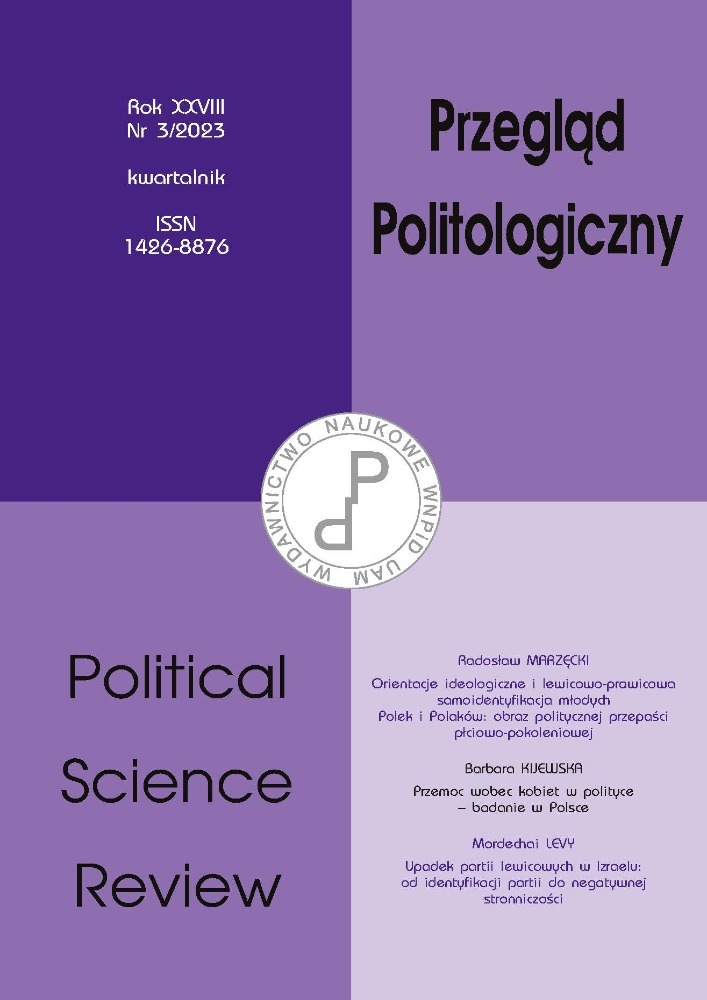Abstract
The left parties are the oldest political institutions in Israel. They were founded before the establishment of the State and were the dominant political force in its first decades. However, since the 1990s, there has been a consistent decline in their power, to the point where, in the last Knesset elections held in 2022, the left parties barely passed the threshold. This article explains the decline of the left parties and attempts to answer where the voters went. A combination of several local and global events that occurred in recent years caused the left parties to distance themselves from the narrative of Zionist Socialism characterizing them and to adopt a new narrative, which less inspires identification of Jewish voters. The article’s main argument is that the voters did not disappear but only changed their political behavior from a state of party identification and voting for the left parties to a state of political opposition and voting against the rightist parties. To illustrate the pattern of behavior, voting data for the Knesset in two communities with different demographic characteristics are presented: Kibbutz Mizra, a socialist commune identified with left voters, and Beit-Shean, a town that is a stronghold of rightist voters. The conclusion is that the way for the left parties to return to dominance is through reintegrating the Jewish identity with the values of justice and equality.
References
Arian A. (1990), Politics and government in Israel, Zmora-Bitan Publishers, Tel-Aviv [Hebrew].
Arian A. (1997), The Second Republic: Politics in Israel, Haifa University Press, Zmora-Bitan Publishers, Tel-Aviv [Hebrew].
Arian A., Shamir M. (1983), The primarily political functions of the Left-Right continuum, “Comparative Politics”, vol. 15, no. 2, pp. 139–158. DOI: https://doi.org/10.2307/421673
Arian A., Shamir M. (2018), On mistaking a dominant party in a dealigning system, in: The Elections in Israel 2003, eds. A. Arian, M. Shamir, pp. 27–52, Routledge. DOI: https://doi.org/10.4324/9781351322287
Bankert A. (2021), Reflections on the past and present of research on partisan identity, “Forum”, vol. 19, no. 3, pp. 459–480. DOI: https://doi.org/10.1515/for-2021-2024
Bein A. (1976), History of the Jewish settlement in Israel, Masada [Hebrew].
Campbell A., Converse P. E., Miller W. E., Stokes D. E. (1960), The American voter, The University of Michigan Press.
Caruana N. J., McGregor R. M., Stephenson L. B. (2015), The power of the dark side: negative partisanship and political behaviour in Canada, “Canadian Journal of Political Science/Revue canadienne de science politique”, vol. 48, no. 4, pp. 771–789. DOI: https://doi.org/10.1017/S0008423914000882
Dalton R. J., McAllister I., Wattenberg M. P. (2002), The Decline of Party Identifications, in: Parties without partisan: political change in advanced industrial democracies, eds. R. J. Dalton, I. McAllister, M. P. Wattenberg, pp. 37–63, Oxford University Press. DOI: https://doi.org/10.1093/0199253099.003.0003
Drummond A. J. (2006), Electoral volatility and party decline in Western democracies: 1970–1995, “Political Studies”, vol. 54, no. 3, pp. 628–647. DOI: https://doi.org/10.1111/j.1467-9248.2006.00617.x
Filc D. (2006), Populism and Hegemony in Israel, Resling, Tel-Aviv.
Goldberg G. (1992), Political parties in Israel – from mass parties to electoral parties, Ramot – Tel-Aviv University [Hebrew].
Greenfield T. (2017), Collapse – The disintegration of the political left in Israel, Miskal – Yedioth Aharonoth, Tel-Aviv [Hebrew].
Horowitz D., Lissak M. (1977), From Yishuv to statehood, Am Oved, Tel-Aviv [Hebrew]. DOI: https://doi.org/10.1179/033443577792432926
Kenig O., Rahat G. (2022), The parties in Israel 1992–2021, The Israel Democracy Institute.
Levy M. (2016a), Changes in Israeli collective identity as a source of tension in the political arena, “Przeglad Politologiczy”, vol. 1, pp. 193–204. DOI: https://doi.org/10.14746/pp.2016.21.1.13
Levy M. (2016b), The Kibbutzim as collective political identity under a change, Doctoral dissertation, Adam Mickiewicz University, Poznan.
Pedersen M. N. (1979), The dynamics of European party systems: changing patterns of electoral volatility, “European Journal of Political Research”, vol. 7, no. 1, pp. 1–26. DOI: https://doi.org/10.1111/j.1475-6765.1979.tb01267.x
Rahat G. (2019), The decline of the group and the rise of the star(s): from party politics to personal politics, The Israel Democracy Institute.
Rahat G., Hazan R. Y., Ben-Nun Bloom P. (2016), Stable blocs and multiple identities: The 2015 Elections in Israel, “Representation”, vol. 52, no. 1, pp. 99–117. DOI: https://doi.org/10.1080/00344893.2016.1190592
Rose R., Mishler W. (1998), Negative and positive party identification in post-communist countries, “Electoral Studies”, vol. 17, no. 2, pp. 217–234. DOI: https://doi.org/10.1016/S0261-3794(98)00016-X
Shamir M., Rahat G. (2022), Four elections in two years, in: The elections in Israel 2019–2021, eds. M. Shamir, G. Rahat, pp. 1–24, Routledge. DOI: https://doi.org/10.4324/9781003267911
Sheafer T., Shenhav S. R., Goldstein K. (2011), Voting for our story: A narrative model of electoral choice in multi-party systems, “Comparative Political Studies”, vol. 44, no. 3, pp. 313–338. DOI: https://doi.org/10.1177/0010414010384372
Zhong C. B., Phillips K. W., Leonardelli G. J., Galinsky A. D. (2008), Negational categorization and intergroup behavior, “Personality and Social Psychology Bulletin”, vol. 34, no. 6, pp. 793–806. DOI: https://doi.org/10.1177/0146167208315457
License
Copyright (c) 2023 Mordechai Levy

This work is licensed under a Creative Commons Attribution-ShareAlike 4.0 International License.

